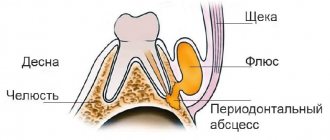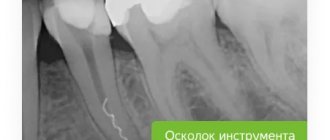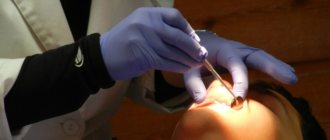We understand what causes unpleasant sensations in a “dead tooth” and determine how to solve the problem. Most of us go to the dentist to restore the beauty of our smile or get rid of painful sensations. One of the most common dental operations is removal of the dental nerve. Of course, at the end of therapy, the patient expects that pain will no longer bother him.
However, quite often a treated tooth without a nerve with a filling or under a crown begins to hurt. To understand why a tooth without a nerve hurts, you need to find out how the pulp removal procedure occurs and figure out what exactly causes the pain.
Can a dead tooth hurt?
Before answering this question, let’s find out what the concept of “dead tooth” means? This is the common name for a tooth in which, for medical reasons, the pulp has been removed - loose fibrous tissue penetrated by nerve endings, blood and lymphatic vessels. We are talking about depulpation (removal of the pulp) in case of inflammation for various reasons: due to advanced caries, fistulas, cysts, etc.
Calling a pulpless tooth “dead” is not entirely correct. It is indeed separated from the circulatory system and the nervous system, but is still a component of the dentofacial apparatus, where each element affects the condition of the others.
Pain in a tooth with a removed nerve most often means that other parts of the system are involved in the pathological process, “transmitting” unpleasant sensations to the tissues associated with this tooth. Thus, a false impression is created that the pulpless tooth hurts.
Read also
What to do if your tooth aches
Sometimes aching pain in a tooth can appear for no apparent reason at first glance.
Why do teeth crumble?
Tooth decay in general, and crumbling in particular, is not an aesthetic problem.
Why does a dead tooth hurt when pressed?
Pain in a tooth without a nerve when biting or pressing can be due to various reasons, and is not necessarily explained by pathology. In the first days after depulpation, discomfort when pressing occurs as a reaction to the procedure itself.
It should be understood that nerve removal and preparation for filling is a microsurgical operation that is impossible without tissue injury. First, the dentist drills out the tooth cavity, then, using special tools - an apex locator and needles of various tapers - penetrates the root and extracts the nerve. Then anti-inflammatory and antibacterial drugs are placed into the cleaned channels.
Post-filling pain
If a filled tooth with a removed nerve hurts for some time, this may be normal, as it can be explained by objective reasons.
- In preparation for a filling, slight damage to the healthy tissue involved in the process may occur. Most often, this is the cause of pain in a dead tooth when pressed. Pains of this origin are called post-filling; they are moderate in nature and, as a rule, disappear after a few days. To relieve discomfort, the doctor usually prescribes painkillers.
- Unpleasant sensations may arise due to the characteristics of the filling material, which expands slightly when entering the root canals and creates pressure on the apex. These pains are temporary and disappear without a trace after a few days.
Intense pain in the tooth under the filling, its sharp increase a few days after the filling and the absence of a tendency to subside after one or two weeks are no longer the norm. This indicates the presence of complications and requires an urgent visit to the dentist's office.
Poorly performed treatment
The cause of pain in a treated tooth due to mechanical action (pressure, biting) may be errors made during endodontic treatment.
- Perforation of the tooth root.
Improper treatment can result in the filling paste extending beyond the root apex into the jawbone tissue. Inflammation under the tooth develops around the foreign body, causing first bursting and then throbbing pain. - Incomplete closure of root canals.
If the length of the canal is incorrectly assessed after filling, part of the cavity remains unfilled, infection develops in the voids, and as a result, when tapped, a tooth without a nerve hurts. - Incomplete depulpation.
If a tooth without a nerve hurts when pressed, this may indicate that the pulp was removed poorly and living tissue remains in the canals. - Poor saliva evacuation.
As a result, pathogenic microorganisms can enter the canal cavity along with the remaining saliva, which leads to tissue infection and pain. - A fragment of a tool in the canal.
Very thin needles used to examine tooth root canals sometimes break and some remain inside, serving as a source of pain and infection. - Specific root structure.
The condition for successful treatment is a completely sealed root system. Some branches, due to the non-standard structure of the apex, are not visible even on an x-ray, and then the dentist is not immune from making a mistake. - The filling is too high.
The ligaments that support the tooth experience increased stress, stretch, and discomfort and pain appear. - Poor quality removal of tissues affected by caries
, which are a source of pathogenic microflora and cause pain in the tooth under the filling.
Pain and swelling of the gums with quality treatment can also be caused by an allergy to a certain type of filling material. In such a situation, the dentist prescribes antihistamines and analgesics.
Cyst
If the nerve has been removed a long time ago—a year or more—and suddenly begins to hurt, the cause may be a root apex cyst. This disease occurs mainly in those teeth that have been subjected to depulpation and treatment. And since the pulp is removed during infection, the likelihood of a cyst subsequently forming is very high.
Inflammation of the trigeminal nerve
A situation where a filled tooth without a nerve hurts when biting or pressing can be caused by trigeminal neuritis. There is no mistake by the dentist here: inflammation can be caused by the treatment process itself. The pain can be constant, paroxysmal, throbbing. In this case, it is not the tooth that needs to be treated, so a neurologist deals with this problem.
Features of nerve removal
Experienced doctors perform depulpation only as a last resort. But sometimes it is impossible to do without it. What is the procedure? First, an x-ray is taken, from which the dentist draws conclusions about the condition of the pulp (nerve tissue), areas around the root and gets an idea of how deep the inflammation has spread. The specialist assesses the length of the nerve and the features of its location, then gets to work and acts in several stages:
- anesthesia: local anesthesia to relieve the patient of inevitable discomfort. Modern drugs make it possible to carry out all manipulations absolutely painlessly,
- caries removal: the dentist drills out the affected areas of enamel and dentin using a drill,
- nerve removal: using a special tool called a pulp extractor, which is screwed into the canal, the dentist removes the neurovascular bundle in several stages,
- expansion and cleaning of the canals: carried out so that the doctor can efficiently clean the canals from remnants of nervous tissue and prepare them for filling. The channels are expanded with thin burs, which help to level and smooth the inner surface of the walls,
- filling: a material specially designed for filling (for example, gutta-percha) is injected to the entire depth of the root. The consistency of this substance allows you to fill the cavity entirely so that there are no empty areas left there. The upper part is covered with composite material. In some cases, a large inlay is placed or a crown is installed over the filling.
A tooth left without a nerve is called “dead.” It becomes insensitive to irritants, and enamel mineralization stops. It loses its whiteness and acquires a dark shade. To restore an aesthetic appearance, the dentist may suggest performing intra-canal whitening, installing a veneer or an aesthetic ceramic (or metal-ceramic) crown.
Pain under the crown when pressing
If after dentures there is pain under the crown of a dead tooth when biting, there may be several reasons. The tooth begins to hurt due to mechanical stress in the near future after prosthetics in the following situations:
- poor-quality filling, which was already mentioned earlier;
- due to incorrectly chosen shape or size of the crown, poor fit to the tooth;
- The fixation of the prosthesis is impaired due to an insufficient amount of cement: this allows food to get under the crown and the development of infection.
If pain does not occur immediately, but some time after installation of the prosthesis, this may be due to the following factors:
- violation of the tightness of the filling, crown;
- improper care of dentures and poor oral hygiene, which contributes to tissue infection and inflammation;
- the expiration date of the prosthesis (usually about 5 years).
Another reason for rapid tooth destruction under the crown, resulting in pain, is treatment with potent drugs for severe diseases, chemotherapy, and radiation exposure.
Attention! Unpleasant sensations without acute pain immediately after prosthetics are accompanied by the process of getting used to the crown. This goes away within two to three days after completion of the procedure. If the pain does not go away within the specified time, but rather intensifies, you need to urgently go to the doctor.
We correct other people's mistakes. Dental retreatment with a 10% discount
Moscow
Main reasons
Pain is a kind of “alarm” from the body, drawing attention to malfunctions in its functioning. The oral cavity is no exception: if a seemingly healthy tooth hurts when pressed, this indicates that something has happened to it. As a rule, the reason is damage to the crown, root, gums, or the presence of an inflammatory process. But provoking factors can be very diverse: injuries, infections, insufficient hygiene and even medical errors. Let's look at each case in more detail.
What symptoms should you see a doctor for?
What to do if a tooth with a removed root hurts under the filling when pressed? During the first few days, do not panic and observe the nature and intensity of the pain. Pain during the week after filling may be a normal reaction of the body to surgical procedures. In what cases do you need to urgently contact the clinic?
- If within 5-7 days the pain does not go away, intensifies, changes its character to acute, pulsating;
- swelling of the gums appears;
- there is an increase in body temperature.
In such situations, you need to urgently see a dentist so as not to worsen the situation.
What can hurt after filling?
The pain associated with the installation of a filling directly depends on the structure of the tooth. It consists of a crown, neck and root. On top, all these structures are covered with hard dental tissues that do not have nerve endings. In the crown area it is dentin and enamel, in the root area it is cement. Inside, under the hard covering in the crown area, there is a dental cavity filled with pulp - a pulp that has many nerve endings and blood vessels. The cavity is connected to root canals, also filled with pulp. In the area of the apex (apex), the root is connected to the bone tissue of the jaw using a ligament - the periodontal ligament, which has excellent innervation.
Conclusion: a tooth can only hurt if the pulp and periodontium are diseased or injured during filling.
Canal cleaning and filling
The most common cause is caries - a pathological process accompanied by the destruction of hard dental tissues. This opens access to the dental cavity, root canals and periodontal tissue, inflammation or irritation of which causes severe pain.
Preparing a tooth for filling
Filling is a method of treating caries, but this process itself can cause mechanical irritation of soft tissues, accompanied by pain. Minor pain may be normal, but sometimes you cannot do without the help of a specialist.
In the superficial and middle stages of caries, the affected hard tissues are removed and a filling is placed on top, restoring the shape of the tooth. The dental cavity remains closed. This treatment is absolutely painless and does not require anesthesia. An even more effective way is to have your teeth professionally cleaned to remove plaque and tartar. Regular implementation of this procedure prevents the development of caries and allows you to keep all your teeth healthy for a long time.
Tooth preparation and depulpation
With deep caries, a hole forms in the hard tissues and an infection enters the dental cavity, causing intense pain. In such cases, before filling, preparation is carried out to remove damaged hard tissues and expand the cavity. If necessary, the old filling is also removed. Then the pulp is removed (depulping).
This is a painful procedure, but modern local anesthetics used in dentistry allow the patient to experience no pain at all. If deep caries has developed not so long ago, and the periodontal tissues are healthy, then it is possible to remove only the pulp from the dental cavity (amputation), after which a therapeutic lining is applied and a temporary filling is installed. If there is no pain, a permanent filling is placed after a few days.
In case of long-standing caries, the pulp is first completely removed from the dental cavity, and then from the root canals (extirpation). At the same time, the cost of filling increases.
It is very important to carefully remove the pulp (patients often call it the nerve) from the canal, making sure that no particles of destroyed hard tooth tissue remain in it. All this can support a long-term inflammatory process.
If a tooth hurts after canal filling, the infection can gradually reach the root apex, causing an inflammatory process in the periodontium, accompanied by fever and pain.
What complications may arise?
Pain in a dead tooth necessarily indicates the presence of some pathology that needs to be eliminated in a timely manner. Infection can lead to serious consequences:
- complete destruction and death of the tooth;
- chronic gum inflammation;
- development of periodontitis, gingivitis;
- the appearance of cysts.
In addition, failure to seek medical help in a timely manner can lead to the development of systemic infections that spread from the periosteum through the bloodstream throughout the body!
How to relieve pain at home
With moderate syndrome, you can cope with pain using traditional recipes.
- Rinsing with a soda-salt solution will help alleviate the condition; decoctions of medicinal plants: oak root, sage, chamomile, calendula.
- A paste of garlic and onion or a piece of propolis is applied to the diseased tooth.
- The submandibular area on the sore side is massaged for one and a half minutes.
For disinfection, rinsing with the antiseptics chlorhexidine and miramistin is recommended. In order not to endure severe pain while visiting the dentist, you can take medical anti-inflammatory and painkillers: aspirin, analgin, Ketanov, Nurofen; treat the problem area with Dentcos and Kamistad gels.
Important! You should not heat the affected area (this will increase inflammation), or use painkillers for a long time without a doctor’s prescription. All of the above measures will help temporarily relieve pain, but will not stop the process.
What to do if your tooth hurts after filling?
If a tooth begins to hurt due to a filling being placed, but its condition does not require additional dental procedures to relieve severe pain, the doctor may prescribe:
- painkillers ; most often these are drugs from the group of non-steroidal anti-inflammatory drugs (NSAIDs); Ketoprofen (Ketonal) has the best analgesic properties; in case of severe pain, it is enough to take a long-acting capsule of 150 mg - these will relieve pain for a day; instead of Ketonal, you can use the rectal suppository Diclofenac - 100 mg; both drugs are contraindicated in the presence of a gastrointestinal ulcer; in such cases, it is better to take a nimesulide tablet (Nise) - it has almost no negative effect on the gastrointestinal tract;
- physiotherapeutic procedures - to reduce pain, electrophoresis with novocaine is prescribed; for swelling, it is better to use hydrocortisone instead of novocaine; Magnetic and laser therapy are also used; the number of procedures depends on the patient’s condition;
- a one-time injection of an antibiotic solution into the periodontal tissues - for problematic traumatic treatment to prevent infectious inflammation and pain.
There are many folk recipes for relieving severe post-filling toothache:
- rinsing the mouth with a decoction of oak bark; Pour 2 tablespoons of crushed bark into a glass of water, bring to a boil, boil for 15 minutes, add boiled water to the original volume, strain and rinse your mouth several times a day; when a tooth hurts, it relieves inflammation, swelling and associated pain well;
- applying a small piece of salted (but not smoked) lard to the gum - this application is especially helpful for pain associated with tissue swelling: salt draws fluid from the tissue, swelling and pain go away;
- a reflex method of pain relief (used in folk medicine for a very long time): grate a clove of garlic on a fine grater, place it in a thin napkin, apply it to the inside of the wrist of the hand opposite the painful tooth, fix it and leave it overnight.
Is it possible to cure a tooth on your own?
Remember: it is impossible to cure a tooth on your own, without the help of a specialist!
All means - medications, folk recipes - have only a temporary, disinfecting and alleviating effect. To get rid of pain, you need to make a correct diagnosis and eliminate the cause, and this can only be done by a dentist in a specialized medical institution using modern diagnostic and treatment technologies. Recommendations for self-treatment of a tooth under a filling can lead to the development of complications even faster.
Treatment of a dead tooth in dentistry
The treatment method for pain in a tooth with a removed nerve depends on the reasons that caused this condition. The dentist will conduct an examination and, if necessary, prescribe an x-ray examination.
- If the cause is unsatisfactory treatment, the filling material is removed, preparation is carried out again, and the canals are inspected with medications placed in them. Then, when the condition returns to normal, the tooth is refilled.
- If the roots are curved, it may be necessary to remove the part that prevents the canals from being cleaned and sealed.
- The cyst or granuloma must be surgically removed along with the pathologically changed tissues around it.
- If there is inflammation of the gums, complex treatment is prescribed. This includes professional teeth cleaning with stone removal, placing medications in periodontal pockets, and taking systemic medications.
- If indicated, physiotherapy procedures are prescribed that have a therapeutic effect on hard tissues.
Remember: by delaying a visit to the dentist, hoping that the pain will go away on its own, you increase the likelihood of serious complications, the treatment of which will be lengthy and possibly expensive.
Methods for restoring the aesthetics of a pulpless unit
Darkening of tooth enamel is an aesthetic problem that not all patients can accept. Dentists offer a number of methods aimed at restoring the external characteristics of a “dead tooth.” What to do in this case? There are 3 main methods for restoring blackened enamel: endobleaching, installation of veneers and crowns. Let's consider each of the listed methods in more detail.
Endobleaching
The method involves introducing whitening agents into the upper layers of the tooth. Typically, dentists use sodium perborate for the procedure. Endo-whitening is possible not only to restore the aesthetics of a “dead” tooth, but also to lighten the enamel tone in healthy teeth.
A healthy element loses its original external characteristics due to a number of factors:
- pulp damage followed by hemorrhage;
- installation of a composite, which began to color the crown of the tooth in a pinkish tint;
- darkening of the crown as a result of silvering of the tooth.
Endobleaching is performed according to the appropriate algorithm:
- Performing professional cleaning to remove hard and soft dental plaque.
- Removing old fillings.
- Injection of a bleaching agent into the cavity of the problematic element.
- Installation of a temporary filling.
The procedure is performed every week until the tooth becomes similar in shade to the rest of the row. The minimum number of visits to the dentist is 4–5 times. The permanent composite material is installed 10 days after the last gel injection procedure.
The results of endobleaching last for an average of 2–3 years. After this time, the procedure is repeated again in cycles. Patients are not recommended to undergo more than 3 courses of whitening due to the risk of crown breakage.
This method has a number of disadvantages:
- Impossibility of predicting the result of restoration.
- The impossibility of completely restoring the enamel due to its dullness.
- There are a number of contraindications to the procedure: allergic reactions to the injected bleaching agents; pregnancy; cracks in the enamel; pathologies of the endocrine system.
Veneers
The structures are thin linings made from several types of materials - ceramics and composites. Ceramic plates are often made from zirconium dioxide or porcelain. Porcelain veneers are identical to the enamel color of healthy units. This is achieved due to the transparency of the composites used.
Composite veneers are more affordable, but their service life does not exceed 5 years. This is due to the fragility of the products and their rapid loss of their original appearance.
Installation of veneers is also carried out in stages:
- Selection of the optimal shade of the plates.
- Grinding of the top layer of enamel for better attachment of the product to the tooth. During the procedure, about 0.5–1.5 mm of enamel is ground off.
- Manufacturing of crowns on special machines using 3D technologies. Products are produced in dental laboratories using impressions previously taken from the patient’s dentition.
- Fixation of finished structures using a special adhesive.
There are contraindications for installing veneers:
- bite pathologies;
- enamel abrasion;
- high risks of dental injury;
- bruxism;
- element wobble.
The most significant disadvantage of veneers is the need to wear them throughout your life. This is due to the fact that the teeth on which the onlays are installed are subjected to preliminary grinding and can no longer be restored.
Crowns
Dentists consider this method of restoring the appearance of a “dead” tooth to be preferable. This is due to several reasons:
- Increasing the strength of a problem unit by 30–60%.
- Possibility of preserving the root during the procedure.
- Possibility of ensuring uniform load on all areas of the jaw.
- Protection of tooth tissues from external negative influences.
- The disadvantage of the procedure is the need to grind the top layer of the tooth.
All methods of restoring a “dead” tooth have a negative impact on its health. In order not to resort to the restoration procedure, it is necessary to follow a number of preventive rules. These include: timely visits to the dentist; competent choice of dental care products; daily hygiene measures; flossing after meals; high-quality cleaning of the surface of the tongue; timely change of toothbrush (once every 3 months).
Prevention
You should not think that a tooth with a removed nerve, deprived of blood supply, will relieve you of dental problems - you have already seen this. On the contrary, such teeth are problematic and therefore require more careful care. They are susceptible to any dental diseases - perhaps, except for pulpitis.
- The main means of prevention is thorough oral hygiene 2 times a day using a brush, dental floss, and mouthwash.
- A balanced diet containing enough vitamins and minerals will help keep your teeth longer.
- Regular visits to the dentist - at least once every 3 months - will make it possible to recognize the problem at the initial stage.
And remember: the best prevention of toothache is not to let the tooth need to be depulped, because the likelihood of subsequent complications is very high.
Author: Elena Kopylova Dentist-endodontist. Work experience more than 12 years.
The information is for reference only. Before treatment, consultation with a doctor is necessary.
Lifespan of a tooth without a nerve
How long does a tooth live without a nerve? The duration of operation is influenced by several factors:
- Quality of oral care after the intervention. Typically, the dentist gives the patient a number of recommendations that he will need to adhere to for 1-2 weeks. All these recommendations are aimed at minimizing the negative consequences after pulp removal. Typically they include: avoiding solid and rough foods; temporary exclusion of coloring foods and drinks from the diet; thorough oral hygiene using brush paste and dental floss; limiting excessive physical activity.
- Food quality. Solid foods consumed immediately after the element is sealed may cause the seal to fall out. In addition, they often cause chips and cracks in the enamel of the problem unit. As mentioned earlier, the “dead” segment is more vulnerable to negative external factors.
- The effect of the treatment.
- Regularity of patient visits to dental clinics.
The patient can independently make the tooth last longer; to do this, you need to follow some rules:
- include in your diet more foods containing phosphorus, calcium and other microelements necessary for teeth;
- take vitamin complexes during the off-season;
- Avoid using whitening toothpastes;
- Avoid using hard bristle brushes.
If the sealed element is destroyed as a result of the inept actions of the doctor or the patient himself, then it will no longer be possible to restore it. The only way out of the situation in this case is to remove the “dead” tooth.











